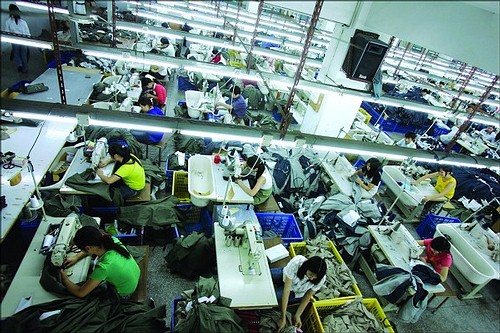The country's manufacturing industry should explore a new growth mode, says an article in People's Daily. The following is an excerpt:
The manufacturing industry is experiencing a hard year. With half a year passing by, the manufacturing industry in the coastal regions has slipped into doldrums.

(File photo)
According to statistics collected by Guangdong province, in the first five months of this year, 11,006 industrial enterprises ran at a loss, rising 12.7 percent in number and accounting for 26 percent of the total number of industrial enterprises in Guangdong. Meanwhile, the total losses of these enterprises rose by 49.3 percent, 25 percent higher than during the same period last year.
The plight of "Made in China" products derives from outside factors such as the appreciation of the Chinese currency, the soaring prices of crude oil and other raw materials, and the slackened pace of world economic growth. All of these factors are squeezing the room for "Made in China" products. In Zhejiang province, 60 percent of the textile and garment enterprises depend on export. For every one percent rise of the Chinese currency, the profit margin of cotton textile, woolen textile and garment will decrease 3.19 percent, 2.27 percent, 6.18 percent respectively. According to statistics of China National Textile and Apparel Council, in the first quarter of this year, the average profit margin of the textile industry is only 0.62 percent for two- thirds of the enterprises in six provinces.
However, the fundamental reason for the current plight lies in the fact that the extensive mode of economic growth can hardly continue. In the past 30 years, cheap labor, low-priced resources and high export subsidies have brought China brilliant achievements. But now with this mode, China faces more and more trade barriers in the world and the rising costs make things even worse.
Therefore, how to continue the competitive edge of the "Made in China" products is a question that deserves an urgent answer. As reports said, local governments such as Zhejiang are actively searching for countermeasures, trying to help enterprises overcome the difficulties. What the government should do now is not to give enterprises subsidies, but encourage them to take on the innovative road.
Take the financial policies for example. Small and medium-sized enterprises are the main producers of the "Made in China" products, but they have great difficulty in getting loans from banks, which severely check their innovative ability. Once the internal economic situation worsens, these small enterprises may be the first to bear the brunt of the pressure. Should the government think about ways to guide the financial institutions to offer services for the upgrading of these small enterprises?
Innovation cannot go without the cultivation of the social values. Few people may bury their heads in research and development if they can gain profits from buying and selling houses; few may work diligently if they pin their hopes on an overnight fortune from the stock market.

Editor: canton fair |




